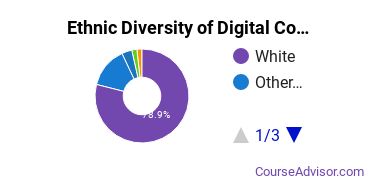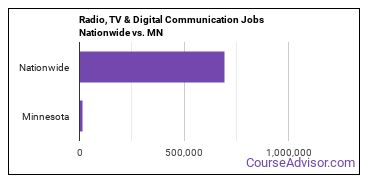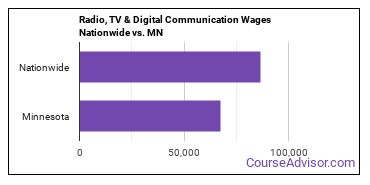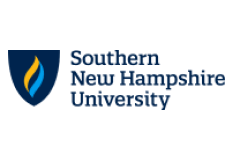Digital Communication Schools in Minnesota
70 Digital Communication students earned their degrees in the state in 2022-2023.
As a degree choice, Digital Communication is the 149th most popular major in the state.
Featured Radio, TV & Digital Communication Programs
Learn about start dates, transferring credits, availability of financial aid, and more by contacting the universities below.
BA in Communication - New Media
Explore the digital frontier as it relates to today's communications strategies with this specialized online bachelor's from Southern New Hampshire University.
MS in Marketing - New Media & Communications
Explore how emerging media impacts the study of culture, relationships and messages with this online master's from Southern New Hampshire University.
Featured Radio, TV & Digital Communication Programs
Learn about start dates, transferring credits, availability of financial aid, and more by contacting the universities below.
BA in Communication - New Media
Explore the digital frontier as it relates to today's communications strategies with this specialized online bachelor's from Southern New Hampshire University.
MS in Marketing - New Media & Communications
Explore how emerging media impacts the study of culture, relationships and messages with this online master's from Southern New Hampshire University.
Education Levels of Digital Communication Majors in Minnesota
Digital Communication majors in the state tend to have the following degree levels:
| Education Level | Number of Grads |
|---|---|
| Bachelor’s Degree | 38 |
| Associate Degree | 24 |
| Award Taking 1 to 2 Years | 6 |
| Award Taking 2 to 4 Years | 6 |
| Award Taking Less Than 1 Year | 2 |
Gender Distribution
In Minnesota, a digital communication major is more popular with men than with women.

Racial Distribution
The racial distribution of digital communication majors in Minnesota is as follows:
- Asian: 1.4%
- Black or African American: 4.3%
- Hispanic or Latino: 7.1%
- White: 77.1%
- Non-Resident Alien: 0.0%
- Other Races: 10.0%

Jobs for Digital Communication Grads in Minnesota
In this state, there are 13,030 people employed in jobs related to a digital communication degree, compared to 692,820 nationwide.

Wages for Digital Communication Jobs in Minnesota
In this state, digital communication grads earn an average of $67,630. Nationwide, they make an average of $86,830.

Most Popular Digital Communication Programs in MN
There are 13 colleges in Minnesota that offer digital communication degrees. Learn about the most popular 13 below:
15 to 1 is the student to faculty ratio. It takes the average student 4.19 years to graduate. Of all the students who attend this school, 100% get financial aid.
Request InformationThe student loan default rate is 0.10% which is lower than average. Of all the teachers who work at the school, 61% are considered full time. This public college charges it's students an average net price of $11,008.
Request InformationOf all the students who attend this school, 100% get financial aid. This private school has an average net price of $17,362. Of all the teachers who work at the school, 51% are considered full time.
Request Information14 to 1 is the student to faculty ratio. This private school has an average net price of $24,183. 52% of the teachers are full time.
Request Information17 to 1 is the student to faculty ratio. Of all the students who attend this school, 100% get financial aid. This private school has an average net price of $20,728.
Request InformationOf all the students who attend this school, 100% get financial aid. Of all the teachers who work at the school, 20% are considered full time. Most students complete their degree in 4.21 years.
Request InformationA typical student attending MSU Moorhead will pay a net price of $17,330. 58% of the teachers are full time. Seeking financial aid? At this school, 96% of students receive it.
Request InformationThis public college charges it's students an average net price of $13,814. The student to faculty ratio is 20 to 1. Of all the teachers who work at the school, 47% are considered full time.
Request InformationThe student to faculty ratio is 10 to 1. It takes the average student 4.25 years to graduate. Of all the students who attend this school, 100% get financial aid.
Request Information54% of the teachers are full time. This public college charges it's students an average net price of $11,398. 17 to 1 is the student to faculty ratio.
Request InformationThe average student takes 4.20 years to complete their degree at North Central University. Students enjoy a student to faculty ratio of 11 to 1. This private school has an average net price of $23,503.
Request Information95% of students are awarded financial aid at this school. Of all the teachers who work at the school, 49% are considered full time. A typical student attending Southwest Minnesota State University will pay a net price of $14,727.
Request InformationA typical student attending Fond du Lac Tribal and Community College will pay a net price of $10,765. 95% of students are awarded financial aid at this school. The full-time teacher rate is 30%.
Request InformationDigital Communication Careers in MN
Some of the careers digital communication majors go into include:
| Job Title | MN Job Growth | MN Median Salary |
|---|---|---|
| Producers and Directors | 8% | $65,770 |
| Media and Communication Workers | 5% | $65,590 |
Related Majors in Minnesota
Below are some popular majors in the state that are similar to digital communication.
| Major | Annual Graduates in MN |
|---|---|
| Communication & Media Studies | 887 |
| Journalism | 292 |
| Public Relations & Advertising | 128 |
| Other Communication & Journalism | 69 |
View all majors related to Digital Communication
Explore Major by State
Alabama
Arkansas
Connecticut
Florida
Idaho
Iowa
Louisiana
Massachusetts
Mississippi
Nebraska
New Jersey
North Carolina
Oklahoma
Rhode Island
Tennessee
Vermont
West Virginia
View Nationwide Digital Communication Report
References
- College Factual
- National Center for Education Statistics
- O*NET Online
- Image Credit: By {} under License
More about our data sources and methodologies.









